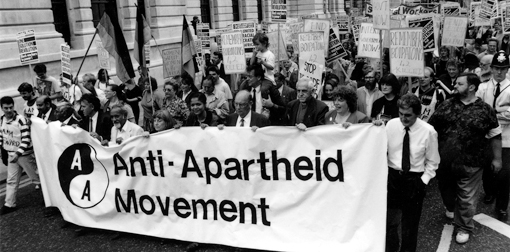Forward to Freedom
The multimedia archives of the Anti-Apartheid Movement are now available online. Christabel Gurney, AAM Archives Committee, provides a tour of this new resource.
About the author: Christabel Gurney was active in the Anti-Apartheid Movement from 1969 to 1994. She edited the AAM’s monthly newspaper Anti-Apartheid News in the 1970s and was later secretary of Notting Hill Anti-Apartheid Group. More recently she has researched and written about the history of the AAM.
Web: www.aamarchives.org
Email: info@aamarchives.org
When the Anti-Apartheid Movement (AAM) dissolved itself – mission accomplished – after the inauguration of Nelson Mandela as South Africa’s President in 1994, it wanted to make its history accessible to future historians and campaigners. Founded as the Boycott Movement in 1959, the AAM campaigned for thirty-five years for the isolation of apartheid South Africa and for support for those fighting against it. It campaigned as well against South Africa’s occupation of Namibia, for independence from colonial rule for Zimbabwe, Mozambique and Angola, and in the 1980s against South Africa’s attacks on its newly independent neighbours. Perhaps surprisingly, for a chronically under-resourced and overstretched pressure group relying largely on volunteers, the AAM had preserved a voluminous quantity of letters, minutes and leaflets. Its records included iconic posters by designers like David King and Ken Sprague, and hundreds of badges, T-shirts, mugs and other campaign ephemera. Unsurprisingly, the material was chaotic and jumbled, much of it mouldering in damp basements and garages.

AAM supporters marched up Whitehall to the South African Embassy to protest against the killing of around 40 township residents at Boipatong on 26 June. They asked the British government to support international monitoring of the violence in South Africa. Among those carrying the banner (l to r) are Peter Hain MP, Billy Nair, Patsy Pillay, Bob Hughes MP, Archbishop Trevor Huddleston and Ken Campbell, General Secretary of the Fire Brigades Union. After the march, Walter Sisulu and Trevor Huddleston led a vigil outside the South African Embassy in memory of those who died. (Date: 1992)
The first step was to conserve and sort this archive. In 1995, a newly formed AAM Archives Committee, made up of AAM Executive Committee members, a historian and a sympathetic archivist, deposited the material at the Library of Commonwealth and African Studies at Rhodes House, part of Oxford’s Bodleian Library. The library raised the funding for a full-time archivist. The connection with Cecil Rhodes, archenemy of African self-determination, was not lost on the Committee, but was accepted in the spirit of reconciliation and the new times. After several years hard work by our committed archivist, Lucy McCann, 800 miscellaneous large cardboard boxes were transformed into around 1,200 archive boxes. This was a rich resource for academic researchers, but only a first stage in making the AAM’s history accessible to people without a Bodleian reader’s card and a taste for delving into archives.
 Learning on Screen
Learning on Screen